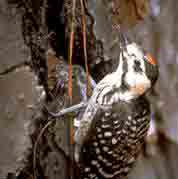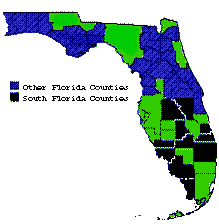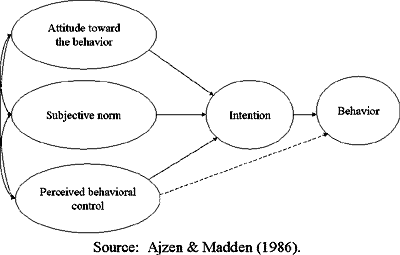A Scientific Approach for Developing a Watershed Education Campaign: Endangered Species in the Everglades Ecosystem
Authors
Janas Sinclair, Frank J. Mazzotti and Jocie A. Graham
Abstract
The federal government has established goals of recovering species native to the Greater Everglades watershed and ensuring that development plans are consistent with ecosystem restoration. The South Florida Multi-Species Recovery Plan (MSRP) addresses these goals by identifying recovery and restoration needs of listed species in the South Florida ecosystem and also providing additional information that could be used in planning and regulatory decisions. Although the MSRP is very well done, the information that it contains is not in a format useful to land use planners and regulators. The goal of this project is to identify how information in the MSRP could be made more useful for land use planning and regulation in Southwest Florida. The Theory of Planned Behavior (TOPB), a social psychological model, will be used to identify the reasons that planners currently do or do not use the MSRP in decision making. Following analysis of survey data, goals will be forwarded for a watershed education campaign directed at regional planners.
 |
 |
| Red Cockaded Woodpecker | Distribution map source: South Florida Multispecies Recovery Plan (green areas contain no woodpeckers) |
Background
In 1993 the federal government initiated the South Florida Ecosystem Restoration Initiative. The goals of this Initiative are to:
- Restore and maintain the biodiversity of native plants and animals in the upland, wetland, estuarine, and marine communities of the South Florida ecosystem.
- Recover species that are threatened or endangered.
- Ensure that development plans or permits for development are fully coordinated among affected governmental agencies and are compatible with restoration.
The South Florida Multi-Species Recovery Plan (U.S. Fish and Wildlife Service, 1998) addresses the goals of the South Florida Ecosystem Restoration Initiative. The MSRP:
- Identifies the recovery and restoration needs of listed species in the South Florida ecosystem (goals 1 & 2).
- Contains information that could be used in planning and regulatory decisions (goal 3).
Problems
- The MSRP was not prepared with regional planners' needs in mind.
- The information needs to be reformatted so that it is useful for Regional Planning Councils.
- Effective 'reformatting' will be based on the factors that determine whether the MSRP is currently used.
Objective
The purpose of this project is to identify the factors that determine whether Regional Planning Council members in Southwest Florida use the South Florida Multi-Species Recovery Plan in land-use decision making.
Approach
The Theory of Planned Behavior (TOPB) is a social psychological model that identifies the antecedents of behavior (Ajzen, 1988; Ajzen & Madden, 1986). In this case, the behavior of interest is using the Multi-Species Recovery Plan in land-use decision making. According to the TOPB, behavior intention is the best predictor of behavior. Behavior intention is determined by three components: a person's evaluation of performing the behavior (AB), perceptions of social pressures to perform or not perform the behavior (SN), and perceptions that one has the required skills and resources to perform the behavior (PBC).
 |
 |
| Source: Us Fish and Wildlife Commission (click for larger image) |
Endangered Florida Panther |
Methods
Survey methodology will be employed to assess planners' behavioral attitudes, subjective norms, and perceived behavioral control with regards to using the MSRP in decision making. Hierarchical multiple regression will be used to test the fit of the TOPB model. Means and correlation coefficients will be examined to identify appropriate goals for a watershed education campaign.

Map of South Florida
Benefits
This project will identify the reasons that Regional Planning Council members do or do not use the South Florida Multi-Species Recovery Plan, which in turn will provide a basis for developing a watershed education campaign. The campaign will address the barriers in knowledge, skills, and/or beliefs that are currently preventing planners from utilizing the MSRP. This communication program will fulfill several 'actions needed' as specified in the MSRP:
- Inform and involve stakeholders in the recovery process.
- Increase public awareness of the species/habitat relationship.
- Increase public awareness at the community level.
Theory of Planned Behavior
Attitude Toward the Behavior
AB is estimated in terms of:
- Beliefs that performing the behavior will lead to outcome i (bi). e.g "I believe incorporating the MSRP in land-use decision making is likely to lead to recovery of threatened or endangered species."
- Evaluation of each outcome i (ei). e.g. "Recovery of threatened or endangered species is important to me."
AB=E BI ei

Subjective Norm
SN is estimated in terms of:
- Beliefs that "significant other", j, approves or disapproves of the behavior (nj). e.g. "Landowner groups think I shouldn't use habitat maps."
- Motivation to comply with the opinion of each "significant other" j (mi). e.g. "In general, I care what landowner groups think I should do."
SN = E NJ mj
Perceived Behavior Control
PBC is estimated in terms of:
- Beliefs that facilitating or inhibitory condition k exists (ck). e.g. "I don't have the skills and/or background needed to interpret habitat maps."
- Perceived power of each condition k to promote or hinder the behavior (pk). e.g. "Not having the skills and background needed to interpret habitat map will prevent me from using the MSRP in land-use decision making.
PBC = E ck pk
Acknowledgments
We thank the Center for Natural Resources at the University of Florida for a seed grant to initiate this project. This project will be funded by the US Fish and Wildlife Service, to support linking the South Florida Multi-Species Recovery Plan to local government planning and regulation.
References
Ajzen I. 1998. Attitudes, Personality and Behavior. Chicago: The Dorsey Press
Ajzen, I., and T. J. Madden. 1986. Prediction of goal-directed behavior: attitudes, intentions and perceived behavior control. Journal of Experimental Social Psychology 22, 453-474.
US Fish and Wildlife Service. 1998. Multi-species recovery plan for the threatened and endangered species of south Florida. Volumes I and II: Technical/Agency Draft. US Fish and Wildlife Service. Vero Beach, Florida.
Citation
Mazzotti, F.J. and J.A. Sinclair. (2001) A Scientific Approach for Developing a Watershed Education Campaign: Endangered Species in the Everglades Ecosystem. Poster presented at the Florida League of Environmental Resource Agencies Annual Conference. Bradenton, FL.
Also presented at:
The 2001 Natural Resources Forum: Watershed Science, Policy, Planning, and Management. Can We Make it in Florida? Tampa, FL.




